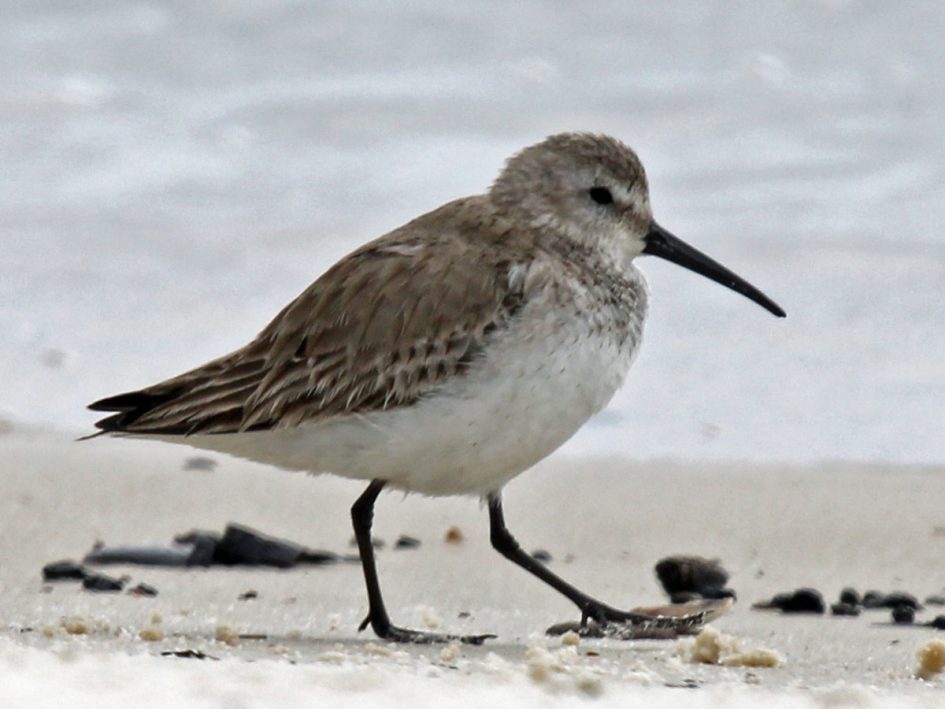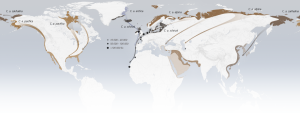Order: Charadrifformes
Family: Scolopicidae
Genus: Calidris
Species: C. alpina
Dunlins are small shore birds with even smaller legs compared to their bodies. The Dunlin has two different plumages depending on the time of the year. During the Dunlins’ breeding period a male adult will have a rusty, red back, a finely streaked chest and a big black patch on it’s tummy. During the winter, an adult male Dunlin will have a brownish gray back with a light gray chest and white belly. The adult females look the same as the males but they are slightly larger with a longer bill. Dunlins have black, medium sized legs and a black stout bill that curves slightly downward at the tip. [Tekiela, S.]
Dunlins can be found all over the northern hemisphere. Dunlins breed up in a circumpolar range in arctic and north temperate regions in places like “Alaska, northeast Canada, east Greenland, Iceland, the British Isles, through north-west Europe, Svalbard and Siberia”. There may even be a wider breeding distribution than is presently known, we just don’t know for sure yet.
“The dunlin is one of the most abundant wader species in the world”. They are so heavily populated that they divided into several subspecies which are geographically isolated. The species of Dunlin that breeds in Europe spend winter from the coast of western Europe in the north down to the Mediterranean and as far south as north-west Africa. [Strom, H.]
https://www.allaboutbirds.org/guide/Dunlin/maps-sightings
Above is a map on AllABoutbird.com to show you how many are being tracked^.
Local Dunlin study:
Interestingly enough, a study was conducted from 1998 to 2000 on Dunlin habitat in the Willamette Valley in Oregon. It was known that Dunlins preffered wetlands but an interesting thing that they also found during their research is that “the females ranged farther from capture sites than males” when they would go out looking for food . But both males and females traveled the most during the winter within their range. These findings indicate that an extensive local movement suggest a “high degree of functional connectivity of habitats”. [Sanzenbacher, P. and Haig, S. 2001]
Dunlins tend stick to shorelines like tidal flats, beaches, muddy pools. They move to a wet tundra in summer and during migration and winter, they are widespread in coastal habitats. Dunlins tend to stick to mainly mudflats, but also sand beaches and rocky shores. Inland, the Dunlins usually occur on lake shores, sewage ponds, flooded fields.
In 2004, a study was done on the Fraser River Delta in British Columbia on habitat preference for Dunlins. The study found that patterns of habitat preference differed between sexes and among separate Dunlin from different sites in the river delta. The researchers found that Dunlins’ showed a significant preference for tidally influenced marine habitats at both scales and throughout the study area.However, most individual Dunlins also used terrestrial habitats, usually during high tide and primarily at night. The role of terrestrial habitats in the ecology of Fraser River delta had been underestimated because these habitats are used far more at night than during the day so they weren’t being studied at the time the area was most populated. [Shepherd P. C. F and Lank, D. 2001]
Basically, these little critters eat smaller little critters.
The diet of a Dunlins varies on the specific Dunlins’ location and the time of season. For example, if a Dunlin is on a coastal shoreline, it will eat aquatic invertebrates and little creatures found in intertidal zones like marine worms, snails and other mollusks, amphipods and other crustaceans, sometimes even small fish. If a Dunlin is located more inland, they will be mostly dependent on critters like worms and insect larvae. On breeding grounds feeds heavily on insects, including midges, crane flies, beetles, and others. Sometimes eats seeds and leaves.. [Warnock, N. D. and R. E. Gill (1996)]
Dunlins eat regularly during the day and at night they tend to utilize different habitats than they do during the day. The biggest example of a different habitat used during the different points of the day is that Dunlins use more soft sediment during the night than they do during day. Nocturnal foraging is important for storing fat deposits in migrating birds.They also pecked during the day and probed at night. [Mouritsen, K. (1994)]
Dunlins shifted from probing to pecking and vice versa for a higher foraging rate. They hypothesize that the shift may be due to “decreasing efficiency of probing due to increases of energy and time caused by decreasing sediment penetrability with time after immersion” [Koloski, Laura]
Some species of Calidris alpina spend their high tide searching for food over the open ocean. Dunlins spend a 43% shorter flight difference after high tide on roosting sites than before high tide in January as opposed to October in November. The reason for this is because of the significant temperature difference. And because of this the Dunlins were hunted by Peregrine Falcons (“who captured 81 prey in the 494 attacks”).This study suggests that predation is the greatest risk for Dunlins that return early from their high tide flight for food. (Dekker, D. 2013)
Breeding habits
Dunlins breed in solitary pairs or loose groups and are territorial on the breeding grounds. The nest is placed in flat, moist terrain near ponds and lakes, usually in concealing vegetation. The nest is bowl-shaped and is lined with straw and willow leaves. The four pear-shaped eggs are buff or olive-brown with chestnut-brown speckles and blotches. Eggs are incubated by both sexes for 22 days.
Love/ Family Habits
The Dunlin is monogamous and the same pair often breeds in the same locality in successive years. The young leave the nest immediately after hatching and are protected by the parents, but the female usually leaves the family before the young are fledged at about three weeks of age.
Flight
Dunlins travel in huge flocks. An interesting behavior they found when they fly is their rotation. The first rotation is course-change movements in which the entire flock altered course. The second rotation they found was rotation movements in which individual birds rotated on their sagittal axes without necessarily changing direction. Either manoeuvre could make a flock’s overall appearance shift suddenly from light to dark (or vice versa) as the birds oriented first with their light ventral, then with their dark dorsal, plumage toward the observer. ‘Self-generated synchrony’ is a possible mechanism for this highly coordinated group behavior. [Davis, J. 1980]
Migration
Dunlin breeding in northern Alaska apparently move west, migrating down the eastern side of Siberia and Asia to Japan and China. In one study conducted in the Yukon of Alaska and the other done in the delta in Alaska (both of these places are in western Alaska) done from 1977 to 2010 found that C. alpina is a polytypic shorebird with complex patterns of distribution and migration throughout its holarctic range. Birds marked on the Yukon were found wintering in both Asia and North America. Individuals of C. a. pacifica marked on the delta were re-sighted significantly farther north, mostly in southern British Columbia and Washington, than birds marked on the second, more southerly staging area on the Alaska Peninsula, which were re-sighted primarily in the San Francisco Bay area of northern California. [Robert E. Gill, Colleen M. Handel, and Daniel R. Ruthrauff ]
An interesting way Dunlins regulate body mass
Dunlins use rainfall as a cue for regulating body mass. The role of body mass regulation in providing insurance against increased starvation risk during deteriorating thermal or foraging conditions, or in reducing the costs of extra mass as conditions improve. [Kelly, J. P. (2002)]
-Tekiela, S. (2001). Birds of Washington: Field guide. Cambridge, MN: Adventure Publications.
-Dekker, D. (2013). High-tide by wintering Dunlins (Caldiris alpina): a weather- dependent trade-off between energy loss and predation risk. Canadian Journal of Zoology, 91(1), 25-29
-Koloski, Laura, et al. “Sex Determination in Breeding Dunlin (Calidris Alpina Hudsonia).” Waterbirds, vol. 39, no. 1, 2016, pp. 27–33.,
-Warnock, N. D. and R. E. Gill (1996). Dunlin (Calidris alpina), version 2.0. In The Birds of North America (A. F. Poole and F. B. Gill, Editors). Cornell Lab of Ornithology, Ithaca, NY, USA
–Kelly, J. P. (2002). Effects of feeding time constraints on body mass regulation and energy expenditure in wintering dunlin (Calidris alpina).
-PHILIPPA C. F. SHEPHERD and DAVID B. LANK “MARINE AND AGRICULTURAL HABITAT PREFERENCES OF DUNLIN WINTERING IN BRITISH COLUMBIA,” Journal of Wildlife Management68(1), (1 January 2004)
-Peter M. Sanzenbacher and Susan M. Haig “RESIDENCY AND MOVEMENT PATTERNS OF WINTERING DUNLIN IN THE WILLAMETTE VALLEY OF OREGON,” The Condor 104(2), (1 May 2002).
-Strøm, H. (n.d.). Dunlin (Calidris alpina). Retrieved from http://www.npolar.no/en/species/dunlin.html
-Davis, J. M. (1980). The coordinated aerobatics of dunlin flocks. Animal Behaviour, 28(3), 668-673.
-Lucy J. Ryan, Jonathan A. Green & Stephen G. Dodd (2016) Weather conditions and conspecific density influence survival of overwintering Dunlin Calidris alpina in North Wales, Bird Study, 63:1, 1-9,
–Robert E. Gill, Colleen M. Handel, and Daniel R. Ruthrauff “Intercontinental Migratory Connectivity and Population Structuring of Dunlins from Western Alaska,” The Condor 115(3), (1 August 2013).
-Page, G. W. and R. E. Gill Jr. (1994). Shorebirds in western North America: late 1800s to late 1900s. Stud. Avian Biol. 15:147-160.
-Custer, T. W. and J. P. Myers. (1990). Organochlorines, mercury, and selenium in wintering shorebirds from Washington and California. Calif. Fish and Game 76:118-125.
-Bent, A. C. (1927). Life histories of North American shorebirds, Part 1. U.S. Nat. Mus. Bull. 142.
Effects of Human activity:
Hunting -Dunlins used to be hunted in the 1800’s but are no longer hunted now, except for a few report from china.-Bent, A. C. (1927)
Chemicals– There hasn’t been enough testing on Dunlins in terms of DDE effect. All that we know is that effects on Dunlins are unknown but falcons that feed on Dunlins experienced a significant thinning in their eggs. In terms of mercury, concentration of mercury in the fresh waters of California and Washington are so high, they are considered sub lethal. Custer, T. W. and J. P. Myers. (1990)
Habitat Loss– Loss of habitat is more severe on wintering grounds but there has been no real effect on breeding grounds because a lot of people do not want to live up in the cold tundra. Habitat loss only occurs in developing areas.-Page, G. W. and R. E. Gill Jr. (1994)
Survival rates of juvenile Dunlin are affected by both weather and density of species. [Lucy J. Ryan, Jonathan A. Green & Stephen G. Dodd (2016)]
Gianna Uriarte is an Evergreen State College student with a passion for conservation. She is in her final year of college and is super passionate about trees, animals and some people.








Leave a Reply